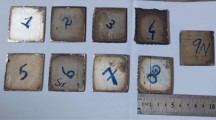Abstract
Electric arc cutting process parameters play a very significant role in determining the cutting effect. Sensitivity analysis can be utilized to identify the process parameters exerting the most influence on the cutting effect and to know the parameters that must be most carefully controlled. Experiment data analysis and finite element method are both introduced to carry out sensitivity analysis based on the response surface methodology. Changeable process parameters such as workpiece thickness, cutting current, and electrode diameter are used as design variables. Cutting hole geometry in experiment part is considered as the response, while the response for PDS is the simulation temperature value by finite element method. The results of two methods both show that a change in process parameters affects the cutting characteristics. The arc cutting process is most sensitive to the cutting current, less sensitive to electrode diameter, and least sensitive to workpiece thickness. It also reveals that experiment data analysis obtains the detail numerical results, and PDS gives an intuitive analysis result without much trial and error.
Similar content being viewed by others
References
Tian X, Liu Y, Lin R, Sun P, Ji R (2013) An autonomous robot for casing cutting in oil platform decommission. Int J Control Autom 6(4):356–362
Asserin O, Loredo A, Petelet M (2011) Global sensitivity analysis in welding simulations—what are the material data you really need? Finite Elem Anal Des 47(9):1004–1016
Afazov SM, Nikov S, Becker AA, Hyde TH (2011) Manufacturing chain simulation of an aero-engine disc and sensitivity analyses of micro-scale residual stresses. Int J Adv Manuf Technol 52(1–4):279–290
Ben Abdessalem A, EI-Hami A (2014) Global sensitivity analysis and multi-objective optimisation of loading path in tube hydroforming process based on metamodelling techniques. Int J Adv Manuf Technol 71(5–8):753–773
Cheng Q, Zhao H, Zhang G, Gu P, Cai L (2014) An analytical approach for crucial geometric errors identification of multi-axis machine tool based on global sensitivity analysis. Int J Adv Manuf Technol 75(1–4):107–121
Karaoğlu S, Seçgin A (2008) Sensitivity analysis of submerged arc welding process parameters. J Mater Process Technol 202(1–3):500–507
Li HP, Liu YL, Zhu X, Yang H (2014) Global sensitivity analysis and coupling effects of forming parameters on wall thinning and cross-sectional distortion of rotary draw bending of thin-walled rectangular tube with small bending radius. Int J Adv Manuf Technol 74(5–8):581–589
Kim IS, Jeong YJ, Son IJ, Kim IJ, Kim JY, Kim IK et al (2003) Sensitivity analysis for process parameters influencing weld quality in robotic GMA welding process. J Mater Process Technol 140(1–3):676–681
Palani PK, Murugan N (2006) Sensitivity analysis for process parameters in cladding of stainless steel by flux cored arc welding. J Manuf Processes 8(2):90–100
An H, Green DE, Johrendt J (2010) Multi-objective optimization and sensitivity analysis of tube hydroforming. Int J Adv Manuf Technol 50(1–4):67–84
Yang D, Li X, He D, Nie Z, Huang H (2012) Optimization of weld bead geometry in laser welding with filler wire process using Taguch’s approach. Opt Laser Technol 44(7):2020–2025
Lee HT, Tai TY (2003) Relationship between EDM parameters and surface crack formation. J Mater Process Technol 142(3):676–683
Erzurumlu T, Oktem H (2007) Comparison of response surface model with neural network in determining the surface quality of moulded parts. Mater Des 28(2):459–465
Acherjee B, Arunanshu SK, Souren M, Dipten M (2012) FEM_Modeling and analysis of simultaneous laser transmission welding of polycarbonates using an FEM and RSM combined approach. Opt Laser Technol 44(4):995–1006
Gaitonde VN, Karnik SR, Faustino M, Paulo J (2010) Machinability analysis in turning tungsten–copper composite for application in EDM electrodes. Int J Refract Met Hard Mater 28(2):221–227
Reh S, Beley J, Mukherjee S, Khor EH (2006) Probabilistic finite element analysis using ANSYS. Struct Saf 28(1–2):17–43
Nakamura T, Fujii K (2006) Probabilistic transient thermal analysis of an atmospheric reentry vehicle structure. Aerosp Sci Technol 10(4):346–354
Liu PF, Zheng JY (2010) Strength reliability analysis of aluminium-carbon fiber epoxy composite laminates. J Loss Prev Process Ind 23(3):421–427
Myers RH, Montgomery DC (2002) Response surface methodology, 2nd edn. Wiley, New York, NY
Delwiche LD, Slaughter SJ The Little SAS® Book: A Primer, Fourth Edition. Cary, NC: SAS Institute Inc
SAS version 8.0. SAS Inc., Cary, NC
ANSYS version 10.0. ANSYS Inc. USA
Eagar TW, Tsai NS (1983) Temperature fields produced by traveling distributed heat sources. Weld J 62(12):346–355
Shankar P, Jain VK, Sundarajan T (1997) Analysis of spark profiles during EDM process. Mach Sci Techno 1(2):195–217
Kansal HK, Singh S, Kumar P (2008) Numerical simulation of powder mixed electric discharge machining (PMEDM) using finite element method. Math Comput Model 47(11–12):11–12
Joshi SN, Pande SS (2010) Thermo-physical modeling of die-sinking EDM process. J Manuf Processes 12(1):45–56
DiBitonto DD, Eubank PT, Patel MR, Barrufet MA (1989) Theoretical models of the electrical discharge machining process—I: a simple cathode erosion model. J Appl Phys 66(9):4095–4103
Tritt TM (2004) Thermal conductivity: theory, properties, and applications, Kluwer Academic/Plenum Publishers Publisher: Springer, 2004 edition American
Author information
Authors and Affiliations
Corresponding author
Rights and permissions
About this article
Cite this article
Tian, X., Liu, Y., Deng, W. et al. Sensitivity analysis for process parameters influencing electric arc cutting. Int J Adv Manuf Technol 78, 481–492 (2015). https://doi.org/10.1007/s00170-014-6672-z
Received:
Accepted:
Published:
Issue Date:
DOI: https://doi.org/10.1007/s00170-014-6672-z




